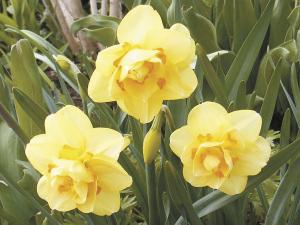Tahiti can be planted by themselves or in clumps
John Lennon wrote of his experiences with his son Sean on the “Double Fantasy” album, “Before you cross the street take my hand. Life is what happens to you while you’re busy making other plans.”
Crossing the street or not, summer is a time of planning. Plan for winter by canning summer tomatoes. And you need to plan now for carefree Tahiti next spring. Tahiti daffodil, that is.
These double daffodils look like tropical yellow and orange gardenias, but are one of the hardiest daffodils around. Talk about carefree, plant Tahiti once and it will not only come back for years it will actually spread on its own. After a few years you will have more bulbs and more flowers. Each bulb you plant will grow into a clump with double, butter yellow flowers with bright centers of flecked-orange red.
Tahiti is a favorite of landscapers as well as the bulb growers in Holland because it is such a hardy, reliable bloomer. They bloom mid-season.
You can plant Tahiti by itself in huge formal borders. Or you can use them in clumps of several bulbs scattered in a lightly shaded woodland or in the yard under deciduous trees.
With full, four-inch blossoms, Tahiti is very good for cutting, so you may want to plan a separate planting as a special cutting garden. They are hardy in USDA Zones 4-8.
Plant the bulbs in well-drained soil in full sun or light shade. Tahiti does best in a soil with a pH between 6-7.0. Plant each bulb in its own hole because it will eventually grow into a clump of plants. You can use a special bulb tool that looks like a crowbar to plant bulbs in grass or meadows. You can use Tahiti as an edge or border. For best effect always plant several staggered rows as a border rather than one single row.
These bulbs are not heavy feeders, which means you do not need to fertilize them. You can cover the beds with two to three inches of an organic mulch such as compost or shredded leaves.
After several years you may want to lift the bulbs and separate them. Carefully dig up the clumps of bulbs in late spring or early fall and separate the bulbs. Replant the bulbs immediately or store in a cool dry place out of the sun until early fall.
If you want to naturalize Tahiti bulbs in a lawn or meadow, you have to let the bulb foliage die down before you mow. If you mow the leaves too soon, the bulbs won’t re-bloom the following year and may even die.
So plan now to plant Tahiti bulbs. You will have years of colorful springs as exotic as a tropical sunset. As for John Lennon’s quote? The expression goes back to American writer Allen Saunders: “Life is what happens to us while we are making other plans.” And, that was in 1957 when Sean Lennon’s father was busy making other plans.





















































